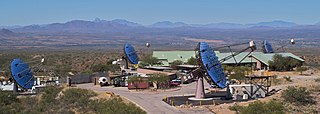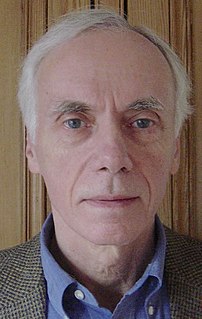The American Physical Society (APS) is a not-for-profit membership organization of professionals in physics and related disciplines, comprising nearly fifty divisions, sections, and other units. Its mission is the advancement and diffusion of knowledge of physics. The society publishes more than a dozen scientific journals, including the prestigious Physical Review and Physical Review Letters, and organizes more than twenty science meetings each year. APS is a member society of the American Institute of Physics. Since January 2020 the organization is led by chief executive officer Jonathan Bagger.

VERITAS is a major ground-based gamma-ray observatory with an array of four 12 meter optical reflectors for gamma-ray astronomy in the GeV – TeV photon energy range. VERITAS uses the Imaging Atmospheric Cherenkov Telescope technique to observe gamma rays that cause particle showers in Earth's atmosphere that are known as extensive air showers. The VERITAS array is located at the Fred Lawrence Whipple Observatory, in southern Arizona, United States. The VERITAS reflector design is similar to the earlier Whipple 10-meter gamma-ray telescope, located at the same site, but is larger in size and has a longer focal length for better control of optical aberrations. VERITAS consists of an array of imaging telescopes deployed to view atmospheric Cherenkov showers from multiple locations to give the highest sensitivity in the 100 GeV – 10 TeV band. This very high energy observatory, completed in 2007, effectively complements the Large Area Telescope (LAT) of the Fermi Gamma-ray Space Telescope due to its larger collection area as well as coverage in a higher energy band.
Noemie Benczer Koller is a nuclear physicist. She was the first tenured female professor of Rutgers College.

Zooniverse is a citizen science web portal owned and operated by the Citizen Science Alliance. It is home to some of the Internet's largest, most popular and most successful citizen science projects. The organization grew from the original Galaxy Zoo project and now hosts dozens of projects which allow volunteers to participate in crowdsourced scientific research. It has headquarters at Oxford University and the Adler Planetarium. Unlike many early internet-based citizen science projects which used spare computer processing power to analyse data, known as volunteer computing, Zooniverse projects require the active participation of human volunteers to complete research tasks. Projects have been drawn from disciplines including astronomy, ecology, cell biology, humanities, and climate science.

Belinda Jane Wilkes is a Senior Astrophysicist at the Smithsonian Astrophysical Observatory (SAO) in Cambridge, Massachusetts, US, and former director of the Chandra X-ray Center.

Beth A. Brown was a NASA astrophysicist with a research focus on X-ray observations of elliptical galaxies and black holes. She earned a Ph.D. in Astronomy from the University of Michigan in 1998, becoming the first African-American woman to do so.

Tracy Robin Slatyer is a professor of particle physics with a concentration in theoretical astrophysics with tenure at MIT. She was a 2014 recipient of the Rossi Prize for gamma ray detection of Fermi bubbles, which are unexpected large structure in our galaxy. Her research also involves seeking explanations for dark matter and the gamma ray haze at the center of the Milky Way. In 2021, she was awarded a New Horizons in Physics Prize for "major contributions to particle astrophysics, from models of dark matter to the discovery of the "Fermi Bubbles."

Vassiliki Kalogera is a Greek astrophysicist. She is a professor at Northwestern University and the Director of the Center for Interdisciplinary Exploration and Research in Astrophysics (CIERA). She is a leading member of the LIGO Collaboration that observed gravitational waves in 2015.

Alice Kust Harding is an American astrophysicist at the NASA Goddard Space Flight Center, Greenbelt, Maryland.

The University of Washington Planetarium is an active planetarium located in the Physics/Astronomy Auditorium on the University of Washington campus in Seattle, WA. The dome is 30 feet in diameter and utilizes six digital projectors to create an interactive display using the Worldwide Telescope planetarium software.
Lynn Cominsky is an American astrophysicist and educator. She is currently the Chair of Astronomy and Physics at Sonoma State University in Rohnert Park, California, as well as the Project Director for the NASA Education and Public Outreach Group.

Angela Villela Olinto is an astroparticle physicist and professor at the University of Chicago as well as the dean of the Physical Sciences. Her work is focused on understanding the origin of high-energy cosmic rays, gamma rays, and neutrinos.
Reva Kay Williams is an American astrophysicist. Williams is the first Black American woman to receive a Ph.D. in theoretical astrophysics and the first person to successfully work out the Penrose process using Einstein's Theory of Relativity to extract energy from black holes.

Rita M. Sambruna is an Italian-American astrophysicist and is the Deputy Director of the Astrophysics Science Division at National Aeronautics and Space Administration's (NASA) Goddard Space Flight Center. Sambruna held the Clare Boothe Luce Professorship in Physics and Astronomy at George Mason University.

Péter István Mészáros is a Hungarian-American theoretical astrophysicist, best known for the Mészáros effect in cosmology and for his work on gamma-ray bursts.
Reshmi Mukherjee is an Indian-American astrophysicist known for her research on gamma-ray astronomy and blazars, involving work based on the Compton Gamma Ray Observatory, VERITAS, Energetic Gamma Ray Experiment Telescope (EGRET), and Cherenkov Telescope Array collaborations. She is Helen Goodhart Altschul Professor of Physics & Astronomy at Barnard College.
Brenda Lynn Dingus is an American particle astrophysicist at the Los Alamos National Laboratory, known for her research on gamma-ray bursts and cosmic rays.
Lucy Marie Ziurys is an American astrochemist known for her work on high-resolution molecular spectroscopy. She is Regent's Professor of Chemistry & Biology and of Astronomy at the University of Arizona.
Elizabeth Anne Hays is an American astrophysicist at the NASA Goddard Space Flight Center, where she is chief of the Astroparticle Physics Laboratory and the project scientist for the Fermi Gamma-ray Space Telescope. Her research has included gamma-ray astronomy of the Crab Nebula, novae, and gamma-ray bursts.
Rene Ashwin Ong is an American astrophysicist known for his work in experimental high-energy astrophysics, astroparticle physics, and particle physics. He is a professor at the University of California, Los Angeles.










